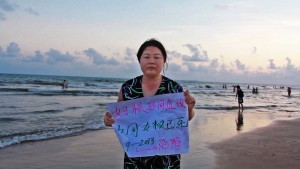
Women’s rights activist, Ye Hiayan (AKA Hooligan Sparrow), holds a sign which reads, “All China Women’s Federation is a Farce. China’s Women’s Rights are Dead.” Source: https://hooligansparrow.com/
Synopsis:
CW: sexual abuse
In Hooligan Sparrow, Chinese-American filmmaker Nanfu Wang documents the experiences of contemporary women’s rights activists in China, namely Ye Haiyan (aka Hooligan Sparrow). After the Chinese government refused to investigate a case of six elementary school girls who were sexually abused by their principal, Hooligan Sparrow and her fellow activists decide to protest in the streets of Hainan Province, calling attention to China’s legal loopholes that allow rapists to claim child victims should be charged with underage prostitution instead of being held accountable for their crimes. Once the women speak out, they are labeled enemies of the state and are met with intense government surveillance and intimidation. Despite multiple altercations with undercover government agents (in which some of her cameras were destroyed), Wang is able to smuggle the film’s guerilla-style footage, shot with concealed body cameras and secret-camera glasses, back to the United States.
One key element of Hooligan Sparrow is Wang’s presence throughout the film. From the very beginning, she situates herself as the filmmaker, explains who she is, and why she traveled back to China after completing film school in the United States. Multiple times in the film, the audience sees Wang’s reflection in mirrors and windows with her camera in hand, or hears her voice in audio recordings; the audience is always aware that Wang is behind the camera. Given Wang’s presence, the film is also able to capture the relationship between the filmmaker and the film’s key characters, adding another layer of depth to the work.
Bibliographic items:
https://madeinchinajournal.com/2019/04/23/hooligan-sparrow-conversation-with-wang-nanfu/ – An interview conducted by journalists Zeng Jinyan and Tan Jia with Nanfu Wang about the editing process and the filmmaker’s perspectives on China.
The Politics of Looking: A Critical Exploration of Hooligan Sparrow
An interview and critical analysis conducted by journalist Rebecca Anderson with Nanfu Wang, which puts Hooligan Sparrow in conversation with the work of French philosopher Jacques Ranciere. Ranciere writes that images produced and circulated by society’s dominant culture shape the public’s perception of what is normal and possible, which helps to explain why authoritarian governments put so much effort into censoring images and other forms of media. Those who wish to disrupt the status quo, therefore, might employ images to inspire political change. Anderson argues that Wang might be considered one such example, given that she weaponizes film to document China’s human rights atrocities and create counternarratives to those of the Chinese government.
— by Allison Naganuma

